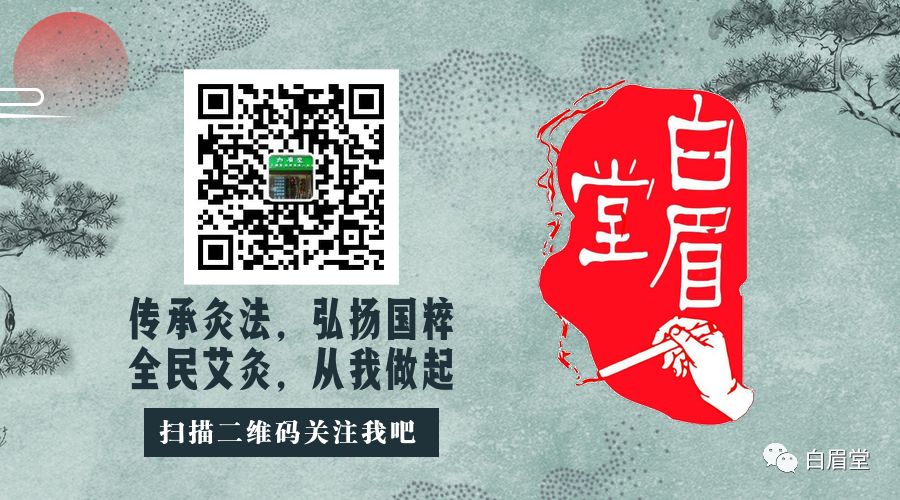When mentioning the term “qi meridians,” many people might think of them as tendons or blood vessels. The twelve meridians in Traditional Chinese Medicine (TCM) indeed include tangible blood vessels and other anatomical structures that are visible to the naked eye. However, the Eight Extraordinary Meridians as described in Daoism, along with the Three Channels and Seven Wheels emphasized in Esoteric Buddhism, serve specific functions but are not visible during human dissection.

Qi is intangible yet has substance, akin to the arrangement of atoms. If we were to use a comparison, it would be like the smoke that rises when a fire is lit; this smoke follows a certain path but does not travel through a defined tube. For many years, Western physiology, as well as we Chinese, have regarded qi meridians as mysterious entities, primarily because they are invisible.
What exactly are these invisible qi meridians? They are neither the breath of life nor the atmosphere in the air, yet they confirm their supreme function in living beings, having a significant impact. Perhaps we can reluctantly refer to them as life energy!
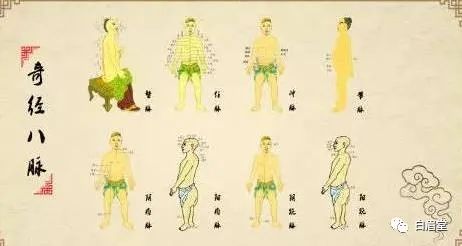
Eight Extraordinary Meridians
The Eight Extraordinary Meridians, which are of utmost importance in Daoism, include: Ren (Conception Vessel), Du (Governing Vessel), Chong (Penetrating Vessel), Dai (Belt Vessel), Yin Wei (Yin Linking Vessel), Yang Wei (Yang Linking Vessel), Yin Qiao (Yin Heel Vessel), and Yang Qiao (Yang Heel Vessel).
Why are they called the Eight Extraordinary Meridians? Because “extraordinary” is a numerical code; from the perspective of yin and yang, “extraordinary” refers to yang. These eight meridians influence the pathways of yang qi, hence they are termed the Eight Extraordinary Meridians. The term “extraordinary” does not imply something strange or unusual.
The Eight Extraordinary Meridians specifically govern the pathways of yang qi. This system is distinct from the twelve meridian system, yet the Eight Extraordinary Meridians assist in regulating the twelve meridians. The Eight Extraordinary Meridians are responsible for the intangible spirit; some believe this corresponds to what Daoism refers to as “jing, qi, shen” (essence, energy, spirit), which is a contentious point. However, TCM theory places significant emphasis on the Eight Extraordinary Meridians.
Why are the Eight Extraordinary Meridians so important? According to Daoist experience, if the Eight Extraordinary Meridians are unobstructed, the mental state can reach a transcendent realm, described as: “When essence is full, one does not crave lust; when qi is full, one does not crave food; when spirit is full, one does not crave sleep.”
How can the Eight Extraordinary Meridians be unblocked? In the “Huangdi Neijing” (Yellow Emperor’s Inner Canon) and Daoist alchemical texts, a metaphor is used: when the qi mechanism of the twelve meridians is full, it can overflow and disperse into the pathways of the Eight Extraordinary Meridians, much like a river or reservoir that, when full, will flow into designated channels. However, how can the qi mechanism of the twelve meridians be filled? This relies on the cultivation and achievement of the practitioner.
Looking at the diagram of the eight meridians in the human body resembles the stars in the sky; no wonder Daoists refer to humans as a small universe. However, regarding this point, the theories of TCM and Daoist alchemy do not completely align.
The Du and Ren meridians originate from the perineum (referred to as the five methods in Esoteric Buddhism). They ascend to the Baihui (Hundred Meetings) point. If the eight meridians are combined with acupuncture, qigong, acupressure, and massage, it undoubtedly represents a treasure trove of new knowledge about human life. It can also herald a new era in medicine.
The Du meridian governs the function of qi, influencing and controlling the entire spinal nerve system.
The Ren meridian governs the function of blood.
For treating male ailments, the Du meridian is emphasized, while for females, the Ren meridian is crucial.
The Wei Chong is the central meridian.
The Dai meridian is central and is particularly important for women; any gynecological issues are related to the Dai meridian.
The Yang Qiao and Yin Qiao, as well as the Yang Wei and Yin Wei, govern the functions of the upper and lower body and the left and right limbs, respectively, in a crosswise manner.
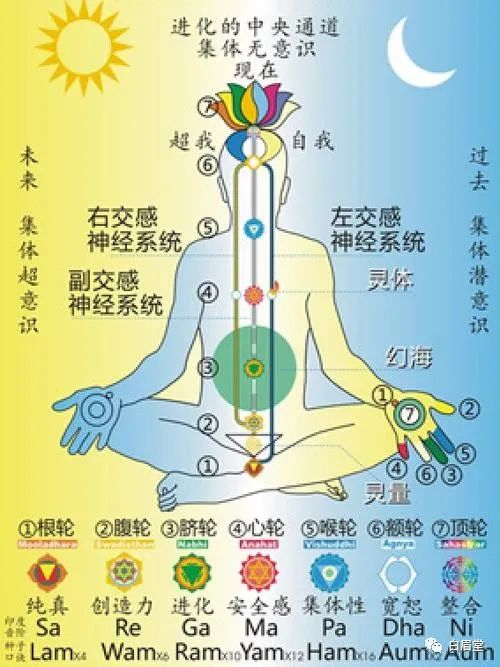
Three Channels and Seven Wheels
The three channels refer to the three qi channels: the central channel, the left channel, and the right channel.
The most important of these is the central channel, which is blue and appears to be in the middle of the spinal cord, extending from the top down to the bottom. The bottom refers to the triangular area in front of the anus; in Esoteric Buddhism, this is called the “Palace of Birth”; for females, the bottom refers to the uterus.
On either side of the central channel are the left and right channels, which run parallel to the central channel, approximately one-tenth the distance of a cow’s hair.
The left channel is red, and the right channel is white. The left channel connects to the right testicle, while the right channel connects to the left testicle; for females, it connects to the uterus.
Because the qi channels are intercrossed, their pathways are related to the nerves; thus, when there is pain on the right side, the left side hurts; when there is pain on the left side, the right side hurts.
Do not assume that the central channel has color and distance, leading you to believe that the three channels are tangible entities visible to the naked eye; that is incorrect. From an anatomical perspective, the three channels are invisible. Only when one practices stillness and the qi channels are unblocked can one see them.
What are the seven wheels? As the name suggests, they are seven locations that are interconnected. The seven wheels are: the crown wheel, the brow wheel, the throat wheel, the heart wheel, the navel wheel, the bottom wheel, and the fontanelle wheel.
The crown wheel is located at the hairline of the forehead, extending back about four finger widths; this is the position of the crown wheel, which is the area that pulsates in infants. According to Daoist teachings, this area is considered pre-natal before it is sealed; at that time, infants do not speak but express themselves richly, as if they are laughing and smiling, because they are still in a metaphysical realm, maintaining contact with their previous spiritual environment. Once the crown wheel is sealed, the infant begins to speak and enters post-natal life. This wheel is also known as the Great Joy Wheel; before the Great Joy Wheel is unblocked during meditation, it is akin to suffering from living torment, with numb legs and sore feet. Once the crown wheel is unblocked, the qi wheel in the brain fills, leading to immense joy. Daoists refer to the head as the “head of all yang,” resembling great joy, with thirty-two qi channels radiating out like an umbrella from the brain.
The brow wheel is located between the two eyebrows, slightly below the Yintang point, and is called the brow wheel. Daoist practitioners and those who meditate, upon unblocking the qi channels at the brow wheel, can experience a state similar to divine powers, known as “eye penetration.” Those who truly possess the heavenly eye can see clearly without any material obstruction. In other words, even with closed eyes and a wall in between, they can see everything in the external world.
The throat wheel is located from the brow wheel down to the Adam’s apple and is called the throat wheel. There are a total of sixteen qi channels here, resembling an inverted umbrella, connecting the channels from the brow wheel to the esophagus and trachea in the upper chest. This throat wheel is also known as the “wheel of enjoyment.” According to Indian healing methods, which emphasize qi channel treatment, if the sixteen channels of the throat wheel are not clean, it is difficult to achieve peace of mind, leading to many worries and illnesses. Therefore, in yoga, there are methods to cleanse the esophagus and stomach using white cloth. In Sichuan, for treating malaria, fresh kudzu root is used; after peeling, it is measured by the patient’s middle finger, and inserted through the mouth into the esophagus and stomach, resulting in a cure for malaria. Thus, maintaining a clean esophagus can lead to health and longevity. When we drink milk, we can see the residue left in an empty cup; milk is merely a fluid, yet we consume several meals a day, and the state of our esophagus is akin to a garbage bin, making it impossible to maintain health and longevity. From personal experience, the throat wheel and stomach wall are extremely difficult to keep clean; the only method is to eat less.
The heart wheel, referred to by mystics as the “law wheel,” is located four inches above the navel (human inches) and has eight channels radiating downwards.
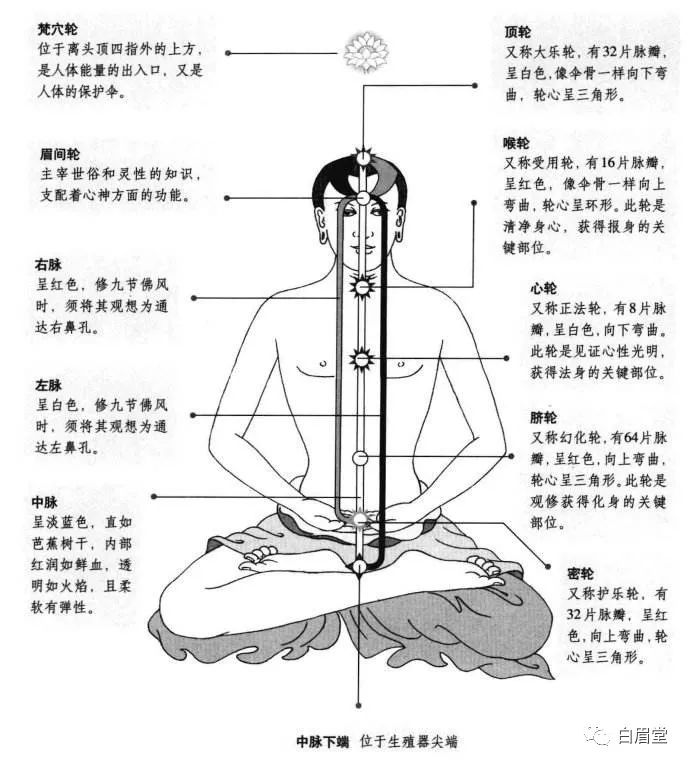
The navel wheel is the center of the nerve plexus, from which sixty-four channels radiate outward, dispersing around the waist, upwards to the heart wheel, and downwards to the heels.
The bottom wheel connects to the channels radiating from the navel, reaching the bottom wheel, which is the male perineum, the triangular area beneath the buttocks, and above the female vaginal opening.
Daoist views on life suggest that the original driving force of male life lies below the body; thus, if a man stands well, with strong and flexible knees, it symbolizes health and longevity. If a man’s legs weaken in old age, it is not a good sign. For women, their vitality lies above the navel, which is why women are not good at standing for long periods and walk with a swaying grace, as their lower body lacks strength.
The fontanelle wheel is the seventh wheel, located outside the human body, above the crown wheel, about four finger widths above the head. Here, the human body radiates light. This notion was once considered somewhat absurd, but recent infrared photography has captured the phenomenon of the human body emitting light, confirming the potential correctness of the fontanelle wheel. It is said that infrared photography proves that any object can emit light, and plants are no exception. Interestingly, when we leave a place we have occupied for three hours, infrared photography can still capture the residual light we left behind.
When we discuss the seven wheels, we have mentioned the number of channels at each wheel: the heart wheel has eight channels, the throat wheel has sixteen channels, the crown wheel has thirty-two channels, and the navel wheel has sixty-four channels. These channels radiate and intersect in an umbrella shape, forming a gourd-like structure. Furthermore, the numbers of these channels, from eight to sixty-four, correspond to the eight trigrams of the “I Ching,” evolving into sixteen, thirty-two, and sixty-four trigrams, which is precisely the same principle. The “I Ching” depicts the phenomena of the universe, and the laws of the seven wheels illustrate that the human body is a small universe.
The eight channels of the heart wheel, plus the sixteen channels of the throat wheel, plus the thirty-two channels of the crown wheel, and finally the sixty-four channels of the navel wheel, total one hundred twenty channels, which correspond to the four major categories of diseases: earth, water, fire, and wind, summarizing the categories and locations of potential diseases in the human body.
——”Daoism, Esoteric Buddhism, and Eastern Mysticism”
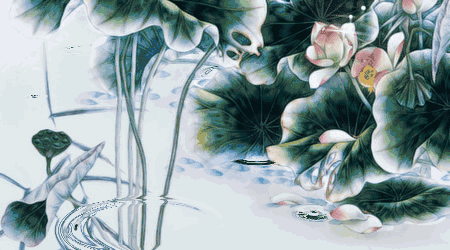
Respectfully dedicated to Nan Huai-Chin
Nan Huai-Chin’s Teachings: The Channels and Wheels in the Human Body (Three Channels and Seven Wheels)
I asked the students from Shaolin Temple, “Are you clear about the three channels and seven wheels?” They replied they were not clear, so I had to draw a simple diagram. At the very least, I have a book titled “Meditation, Cultivation, and Longevity” that you have not read! The twelve meridians and the Eight Extraordinary Meridians of TCM and Daoism, as well as the three channels and seven wheels of Indian yoga, are roughly illustrated in this book. The three channels and seven wheels emphasized in India are entirely different from the twelve meridians and Eight Extraordinary Meridians emphasized in TCM and Daoism; the three channels and seven wheels pertain to the realm of meditation.
Did you not hear my conversation with Master Ding earlier? The realm he reached, I said, “The last blue light descends,” and he agreed. The central channel is blue, so when the central channel is open, you experience a vast brightness, akin to standing atop a mountain, like the clear blue sky above the Himalayas; it is similar to the realm seen by scientists in space. Thus, the blue sky is a deep blue; the color is not ultimately black; black is merely a deep blue.
Monk Ding: “Below is like water.”
Master Nan: “That is an accidental realm. Why did you see it as water at that time? The ‘great water’ below has not yet dissolved.”
This central channel, starting from the crown of the head, connects slightly behind the brain to the void, extending down to the bottom. For males, the bottom is located between the reproductive organs and the anus, forming a triangular area. Therefore, the “mandala” in Esoteric Buddhism depicts a triangle or square, representing the key points of qi channels in the body. At this point, it connects with the central channel, descending from the left side, related to the left nostril, and continues down to the right testicle of the body; this is the left channel. The right side of the head descends to the left testicle of the body; this is the right channel. The right channel is absolutely related to the liver, gallbladder, intestines, and stomach; issues with bowel movements or gastrointestinal problems are primarily associated with the right channel; while issues like nocturnal emissions and premature ejaculation are absolutely related to the left channel.
Is anyone wondering whether this applies to males or females? It is the same; there is no difference between genders. When a female cultivates to a certain stage, it is the same; externally, there is no change, and she appears female, but the pathways of qi channels are the same. The bottom of a female is different from that of a male, yet the function of the triangular area remains the same.
The so-called seven wheels, in Indian culture, are called “wheels”; in Tibetan Esoteric Buddhism, which is derived from Indian culture, they are also called “wheels”; we refer to them as locations, seven locations. The “bottom wheel” rises to the “navel wheel”; above the navel is the “heart wheel” (the area of the heart), then the “throat wheel” (less pronounced in females, more prominent in males). The throat wheel is referred to in Daoism as the “gateway of life and death”; we can feel the throat bone, which is two interlocked pieces. When cultivated, it will open, and internally, it will be unblocked. Therefore, some people say that once the qi channels are open, just by standing in front of me, even as an outsider, I can generally tell whether the gateway of life and death is open. If it is open, despite the presence of this bone, its appearance is different. The throat wheel leads to the brow wheel and the crown wheel; externally, there is also the fontanelle wheel, totaling seven parts, but the central channel is the most important.
There are some practitioners of Esoteric Buddhism who attack Daoism as an external path, claiming that only Esoteric Buddhism is correct. I have always liked to defend the truth; in front of Western medicine, I say TCM is good; in front of TCM, I say Western medicine is correct; in front of Esoteric Buddhism, I say Daoism is superior; and in front of Daoism, I say Esoteric Buddhism is more complete. Thus, I have been criticized from all sides throughout my life, but I do not seek to please anyone. I believe prejudice is terrible because each school has its own reasoning, and it is a matter of not integrating them. The three channels and seven wheels are centered around the central channel; some Esoteric practitioners believe that Daoist Eight Extraordinary Meridians do not include the central channel; I argue that the Eight Extraordinary Meridians do include the central channel, which in the “Huangdi Neijing” is referred to as the Chong meridian; this “Chong” is essentially the same as the “central”.
The central channel discussed in yoga and Esoteric Buddhism starts from the bottom and connects to the crown fontanelle; once unblocked, it connects with the universe, akin to Zhuangzi’s saying, “Communicating with the spirit of heaven and earth.” Many people, whether studying Buddhism or Daoism, believe their central channel is already open; this should not be taken lightly. I must first clarify that I have not opened it! When the qi channels are truly opened, each section will have its own symbolism and function. Once the qi channels are open, the inherent spiritual powers and intelligence will certainly be present; this is not a joke. If your body feels swollen, do not assume that your qi channels are open; this is a scientific matter, not based on your imagination.
I often ask people, “When the qi channels are open, to what extent should they be turned?” They do not know that it must be turned to the point of “the sun and moon merging, the celestial sphere ceasing to rotate”; ultimately, there is no sensation of the body, and the body seems to dissolve. Once dissolved, there is no longer a problem with qi channels; thus, at the very least, one must be able to forget the body, to forget that they have a body. A few days ago, several old friends were trying on new shoes, and I joined them in trying on a pair of monk shoes; everyone felt pain in their feet. I said, “Take it slow; shoes only become comfortable after they are worn in.” Zhuangzi once said, “Forget your feet, and the shoes will fit well”; the most comfortable time is when you forget you have feet. However, at this time, the shoes are also about to wear out; new shoes may be valuable, but if you cannot forget your feet, they will be uncomfortable.
The same principle applies to meditation; if you still feel your body and have a sensation of qi channels, it indicates that the Eight Extraordinary Meridians are not yet open! If you are radiating light and shaking the earth, it proves that you have not yet forgotten your body. Even if you have forgotten your body, it is still only a preliminary stage; the physical body has not yet undergone a complete transformation. Once the transformation occurs, even an elderly body will become as flexible as that of an infant.
Some Esoteric practitioners do not acknowledge the relationship between the Du meridian and the central channel, but yoga differs; yoga considers the central channel to be at the center of the spinal cord, as fine as a cow’s hair, and describes it in tangible terms. Those who have truly opened their qi channels do not need to close their eyes; they can see their internal body clearly, which is called internal illumination or internal vision. Internal vision refers to looking back at oneself, seeing the flow of blood and the internal state clearly.
Now we know that Daoism speaks of a “root orifice”; does the exoteric Buddhism mention this? Yes, it does; this term is called the “Palace of Birth” in Esoteric Buddhism, which is derived from India and is also shared among all schools of yoga and Buddhism.
For instance, Daoism firmly believes that the area below the navel is crucial, referred to as guarding the lower dantian; is there a reason for this? Yes, there is. In Tibetan Buddhism, this part is the navel wheel, which Esoteric Buddhism does not openly discuss, considering it a secret not to be shared, unlike my open discussion. In truth, I consider these to be trivial; the real essence is not these, so I do not care. Generally, Esoteric practitioners regard this as a treasure, a secret passed down through the ages, while Esoteric Buddhism has another term called “transformation wheel,” which refers to the return to unity. Frankly speaking, the so-called transformation wheel indicates that all beings in the desire realm are born from the lower part, so the essence and sperm are located here.
This so-called qi wheel is like an electric cable; our bodies have many cables, including the nervous system that rises from the navel wheel, which is the heart wheel in Esoteric Buddhism. The heart wheel also has many channels, which Daoism refers to as the “Jiang Palace,” naturally colored red, containing the spirit. Thus, the concepts in Chinese and foreign traditions are quite similar, each with its own terminology, strengths, and insights.
Moving up to the throat wheel, which Esoteric Buddhism calls the “wheel of enjoyment,” Daoism refers to this area as the “twelve-story building”; here, the soft bones are twelve sections, and our food passes through here. The throat wheel is referred to in Daoism as the “gateway of life and death.” We can feel the throat bone, which consists of two interlocked pieces. When cultivated, it will open, and internally, it will be unblocked. Therefore, some people say that once the qi channels are open, just by standing in front of me, even as an outsider, I can generally tell whether the gateway of life and death is open. If it is open, despite the presence of this bone, its appearance is different. The throat wheel leads to the brow wheel and the crown wheel; externally, there is also the fontanelle wheel, totaling seven parts, but the central channel is the most important.
The crown wheel, known in Esoteric Buddhism as the “Great Joy Wheel,” is more clearly defined in Esoteric Buddhism; you can understand it just by its name. Therefore, to attain great joy, all qi channels must be open, especially the crown wheel; one will be in joy all day long. The pleasures of ordinary beings are found in the lower body, where the interactions of yin and yang occur, and the pleasures of male and female interactions are quite coarse. Once the crown wheel’s qi channel is open, one experiences joy day and night. Thus, Buddhism speaks of meditation leading to joy beyond birth and joy arising from meditation. If the qi channel of the crown wheel is not open, it is impossible to attain joy! This joy is of an incomparable nature, reaching the tips of the hair. If one reaches this state of joy, all worldly pleasures become insignificant and unworthy of attention.
“I Speak of the Harmony of the Two”

○ We maintain neutrality regarding the viewpoints in this text, provided for reference and exchange purposes ○
○ Content sourced from the internet, copyright belongs to the original author ○
○ If there is any infringement, please contact us for removal ○
